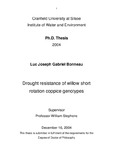JavaScript is disabled for your browser. Some features of this site may not work without it.
| dc.contributor.advisor | Stephens, William | en_UK |
| dc.contributor.author | Bonneau, Luc Joseph Gabriel | en_UK |
| dc.date.accessioned | 2005-11-23T13:48:30Z | |
| dc.date.available | 2005-11-23T13:48:30Z | |
| dc.date.issued | 2004-12 | en_UK |
| dc.identifier.uri | http://hdl.handle.net/1826/905 | |
| dc.description.abstract | This thesis reports on an investigation of drought resistance of willow SRC genotypes. Experiments were conducted at Silsoe, Bedfordshire, in pots and field trials in 2002 and in lysimeters in 2003 to evaluate the range of water use efficiency (WUE) of 50 willows varieties (Salix sp.) and isolate morpho-physiological traits related to WUE and drought resistance. Within the genotype pool tested there was a wide range of responses. The results depict the morpho-physiology of an ideal candidate that plant breeding could produce for drier area of UK, which are summarised below. Its cuttings do not develop calluses when stored in darkness at +4°C. After planting, the candidate does not grow rapidly but has an early exponential phase of stem elongation, after a year of growth it has few stems per stool (< 5). Its long, narrow (Rl/w > 8) hairless leaves are characterised by small adaxial epidermal cells (AECS < 330µm2). The ideal candidate prioritises less biomass to its root system (root/shoot < 0.8) mainly in the top 0.2 m. When grown under optimum condition, the large leaf area has high stomatal conductance and leaf temperature. As water stress progresses, the leaf area decreases leaving little time for leaves to senesce and few yellow leaves remain on the stems. The stomatal conductance decreases slowly and the leaf temperature is almost unaffected. If water stress occurs before August the candidate is able to recover faster the initial physiological state and grow new leaves when re-watered. The results indicate that the best parents to produce such candidate are S. viminalis and S. schwerinii or their related hybrids. Water use (WU) of high yielding willow short rotation coppice hybrids is similar which indicates that the opportunity to reduce WU is limited and that productivity can be only improved by increasing WUE to produce above ground biomass and drought resistance. The current willow breeding programme has great chance to produce hybrids with high WUE however the production of a progeny population from high yielding hybrids that contrast widely in resistance to water stress is recommended. In theory, from such a population, valuable data on morpho-physiological traits related to drought resistance and high WUE can be collected and help genomics to develop quantitative trait loci to the condition that reference hybrids are grown along to quantify the level of water stress experienced by the planting. | en_UK |
| dc.format.extent | 1946 bytes | |
| dc.format.extent | 4177116 bytes | |
| dc.format.mimetype | text/plain | |
| dc.format.mimetype | application/pdf | |
| dc.language.iso | en | en_UK |
| dc.publisher | Cranfield University | en_UK |
| dc.title | Drought resistance of willow short rotation coppice genotypes | en_UK |
| dc.type | Thesis or dissertation | en_UK |
| dc.type.qualificationlevel | Doctoral | |
| dc.type.qualificationname | PhD | |
| dc.publisher.department | Cranfield University at Silsoe |
